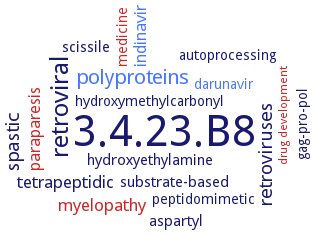3.4.23.B8: human T-cell leukemia virus type 1 protease
This is an abbreviated version!
For detailed information about human T-cell leukemia virus type 1 protease, go to the full flat file.

Word Map on EC 3.4.23.B8 
-
3.4.23.B8
-
retroviral
-
polyproteins
-
spastic
-
retroviruses
-
myelopathy
-
tetrapeptidic
-
paraparesis
-
indinavir
-
hydroxyethylamine
-
aspartyl
-
substrate-based
-
scissile
-
peptidomimetic
-
medicine
-
hydroxymethylcarbonyl
-
autoprocessing
-
darunavir
-
gag-pro-pol
-
drug development
- 3.4.23.B8
-
retroviral
- polyproteins
-
spastic
-
retroviruses
- myelopathy
-
tetrapeptidic
- paraparesis
- indinavir
-
hydroxyethylamine
-
aspartyl
-
substrate-based
-
scissile
-
peptidomimetic
- medicine
-
hydroxymethylcarbonyl
-
autoprocessing
- darunavir
-
gag-pro-pol
- drug development
Reaction
Processing at the authentic HIV-1 PR recognition site and release of the mature p17 matrix and the p24 capsid protein, as a result of the cleavage of the -SQNY-/-PIVQ- cleavage site. =
Synonyms
C2A HTLV-1 PR, HTLV-1 PR, HTLV-1 protease, HTLV-I PR, HTLV-I protease, human T cell leukemia virus PR, human T cell leukemia virus protease, human T-cell leukemia virus type 1 protease, human T-lymphotropic virus type I protease, More, retropepsin (human T-cell leukemia virus), simian T-cell leukemia virus endopeptidase
ECTree
Advanced search results
Crystallization
Crystallization on EC 3.4.23.B8 - human T-cell leukemia virus type 1 protease
Please wait a moment until all data is loaded. This message will disappear when all data is loaded.
all-atom molecular dynamics simulations for both retroviral proteases from HIV-1 and HTLV-I in their ligand-free states and in complex with model substrates. The two catalytic aspartates D32/D32' of HTLV-PR exhibit slightly repulsive interactions with the substrate. Inspection of the electrostatic interaction energy, reveals a large attractive electrostatic interaction of D32/D32' with the substrate that overcompensates for the repulsive van der Waals interactions. The nonconserved residues HIV-PR D30/D30' and HTLV-PR M37/M37' also contribute strongly to the binding of the substrate analogs in both proteases. Interactions in both proteases occur at the same spatial sites and with similar binding energies. There care high similarities between the dynamic behaviors of the flap structures, especially in the ligand-free state
computer-assisted modeling experiments on inhibitor N2-[(2S)-2-amino-2-(2,4,6-trifluorophenyl)ethyl]-N-[(2S)-4-[(4R)-4-[(2,2-dimethylpropyl)carbamoyl]-5,5-dimethyl-1,3-thiazolidin-3-yl]-4-oxo-1-phenylbutan-2-yl]-3-methyl-L-valinamide in complex with a truncated L40I mutation HTLV-I protease show that hydrogen bond interactions are present throughout the backbone anchoring the docked compound with the catalytic Asp32 and Asp320 residues from each respective chain of the homodimeric protease, along with Gly340, Asp360, and Leu570. Hydrogen bond interactions with Asp36 and the flap residues Ala59 and Ala590 are mediated through water. Hydration of the terminal free amino group mediates a link with the amide nitrogen of Leu570
-
computer-assisted modeling using inhibitors N2-[(2S)-2-(b-alanylamino)-2-phenylacetyl]-N-[(2S)-4-[(4R)-4-[(2,2-dimethylpropyl)carbamoyl]-5,5-dimethyl-1,3-thiazolidin-3-yl]-4-oxo-1-phenylbutan-2-yl]-3-methyl-L-valinamide and N2-[(2S)-2-(butanoylamino)-2-phenylacetyl]-N-[(2S)-4-[(4R)-4-[(2,2-dimethylpropyl)carbamoyl]-5,5-dimethyl-1,3-thiazolidin-3-yl]-4-oxo-1-phenylbutan-2-yl]-3-methyl-L-valinamide
-
HTLV-1 PR complexed with Ac-Ala-Pro-Gln-Val-Sta-Val-Met-His-Pro, hanging drop vapor diffusion method, using 17% (w/v) PEG 8000, 16% PEG (w/v) 300, 0.1 M sodium acetate (pH 5.2), at 20°C. HTLV-1 PR complexed with KNI-10562, hanging drop vapor diffusion method, using 26% (w/v) pentaerythritol ethoxylate and 0.2 M ZnSO4 in 0.1 M Bis-Tris buffer (pH 5.2), at 20°C. HTLV-1PR complexed with KNI-10683, hanging drop vapor diffusion method, using 17% (w/v) PEG 8000, 16% (w/v) PEG 300, 10 mM dithiothreitol, and 0.2M KH2PO4 in 0.1 M Bis-Tris buffer, pH 5.2, at 20°C
-
molecular dynamics simulation. In the apo-enzyme, the two catalytic residues are chemically equivalent and are expected to be both unprotonated. Upon substrate binding, the catalytic residues of HTLV-1 protease evolve to a singly protonated state, in which the carboxylic oxygen atom OD1 of Asp32 is protonated and forms a hydrogen bond with the OD1 atom of Asp32' , which is unprotonated
purified enzyme in complex with inhibitors 9 and 10, X-ray diffraction structure determination and analysis at 2.8 A and 3.25 A resolution, respectively, modelling
-
purified recombinant HTLV-1 PR in complex with inhibitor Ac-Ala-Pro-Gln-Val-statine-Val-Met-His-Pro, enzyme-inhibitor ratio of 1:10, 5°C, hanging drop vapor diffusion method, mxing of 0.004 ml of protein solution and of well solution, the latter containing 17% PEG 8000, 16% PEG 300, and 10 mM DTT, in 0.1 M acetate buffer, pH 5.2, X-ray diffraction structure determination and analysis at 2.6 A resolution, structure analysis and modeling, overview
-
sequence and structural alignments of HTLV-1 protease and HIV-1 protease. 95% of ligand recognizing active site amino acids are common in both receptors, the approved drugs of HIV proteases are unable to function as HTLV-1 protease inhibitors. The reported amino acid Asp30 from HIV-1 proease is substituted as Met37 in HTLV protease. Met37 is playing the vital role in ejection of HIV protease inhibitors from the binding pocket of HTLV protease


 results (
results ( results (
results ( top
top





